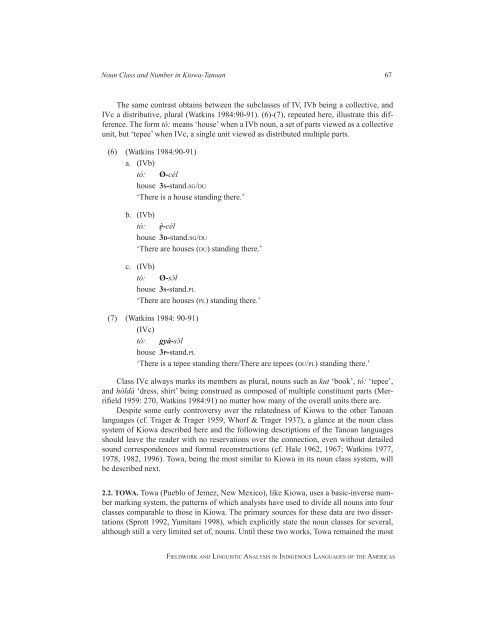Fieldwork and Linguistic Analysis in Indigenous ... - ScholarSpace
Fieldwork and Linguistic Analysis in Indigenous ... - ScholarSpace
Fieldwork and Linguistic Analysis in Indigenous ... - ScholarSpace
You also want an ePaper? Increase the reach of your titles
YUMPU automatically turns print PDFs into web optimized ePapers that Google loves.
Noun Class <strong>and</strong> Number <strong>in</strong> Kiowa-Tanoan 67<br />
The same contrast obta<strong>in</strong>s between the subclasses of IV, IVb be<strong>in</strong>g a collective, <strong>and</strong><br />
IVc a distributive, plural (Watk<strong>in</strong>s 1984:90-91). (6)-(7), repeated here, illustrate this difference.<br />
The form tó: means ‘house’ when a IVb noun, a set of parts viewed as a collective<br />
unit, but ‘tepee’ when IVc, a s<strong>in</strong>gle unit viewed as distributed multiple parts.<br />
(6) (Watk<strong>in</strong>s 1984:90-91)<br />
a. (IVb)<br />
tó: Ø-cél<br />
house 3S-st<strong>and</strong>.sg/du<br />
‘There is a house st<strong>and</strong><strong>in</strong>g there.’<br />
b. (IVb)<br />
tó: ę̀-cél<br />
house 3D-st<strong>and</strong>.sg/du<br />
‘There are houses (du) st<strong>and</strong><strong>in</strong>g there.’<br />
c. (IVb)<br />
tó: Ø-sɔ́l<br />
house 3S-st<strong>and</strong>.Pl<br />
‘There are houses (Pl) st<strong>and</strong><strong>in</strong>g there.’<br />
(7) (Watk<strong>in</strong>s 1984: 90-91)<br />
(IVc)<br />
tó: gyà-sɔ́l<br />
house 3P-st<strong>and</strong>.Pl<br />
‘There is a tepee st<strong>and</strong><strong>in</strong>g there/There are tepees (du/Pl) st<strong>and</strong><strong>in</strong>g there.’<br />
Class IVc always marks its members as plural, nouns such as kut ‘book’, tó: ‘tepee’,<br />
<strong>and</strong> hóldà ‘dress, shirt’ be<strong>in</strong>g construed as composed of multiple constituent parts (Merrifield<br />
1959: 270, Watk<strong>in</strong>s 1984:91) no matter how many of the overall units there are.<br />
Despite some early controversy over the relatedness of Kiowa to the other Tanoan<br />
languages (cf. Trager & Trager 1959, Whorf & Trager 1937), a glance at the noun class<br />
system of Kiowa described here <strong>and</strong> the follow<strong>in</strong>g descriptions of the Tanoan languages<br />
should leave the reader with no reservations over the connection, even without detailed<br />
sound correspondences <strong>and</strong> formal reconstructions (cf. Hale 1962, 1967; Watk<strong>in</strong>s 1977,<br />
1978, 1982, 1996). Towa, be<strong>in</strong>g the most similar to Kiowa <strong>in</strong> its noun class system, will<br />
be described next.<br />
2.2. TOWA. Towa (Pueblo of Jemez, New Mexico), like Kiowa, uses a basic-<strong>in</strong>verse number<br />
mark<strong>in</strong>g system, the patterns of which analysts have used to divide all nouns <strong>in</strong>to four<br />
classes comparable to those <strong>in</strong> Kiowa. The primary sources for these data are two dissertations<br />
(Sprott 1992, Yumitani 1998), which explicitly state the noun classes for several,<br />
although still a very limited set of, nouns. Until these two works, Towa rema<strong>in</strong>ed the most<br />
fieldwork <strong>and</strong> l<strong>in</strong>guistic analysis <strong>in</strong> <strong>in</strong>digenous languages of the americas

















